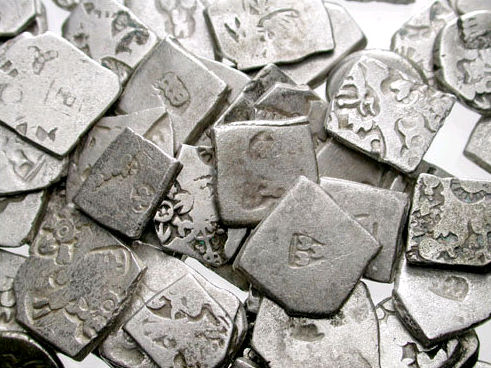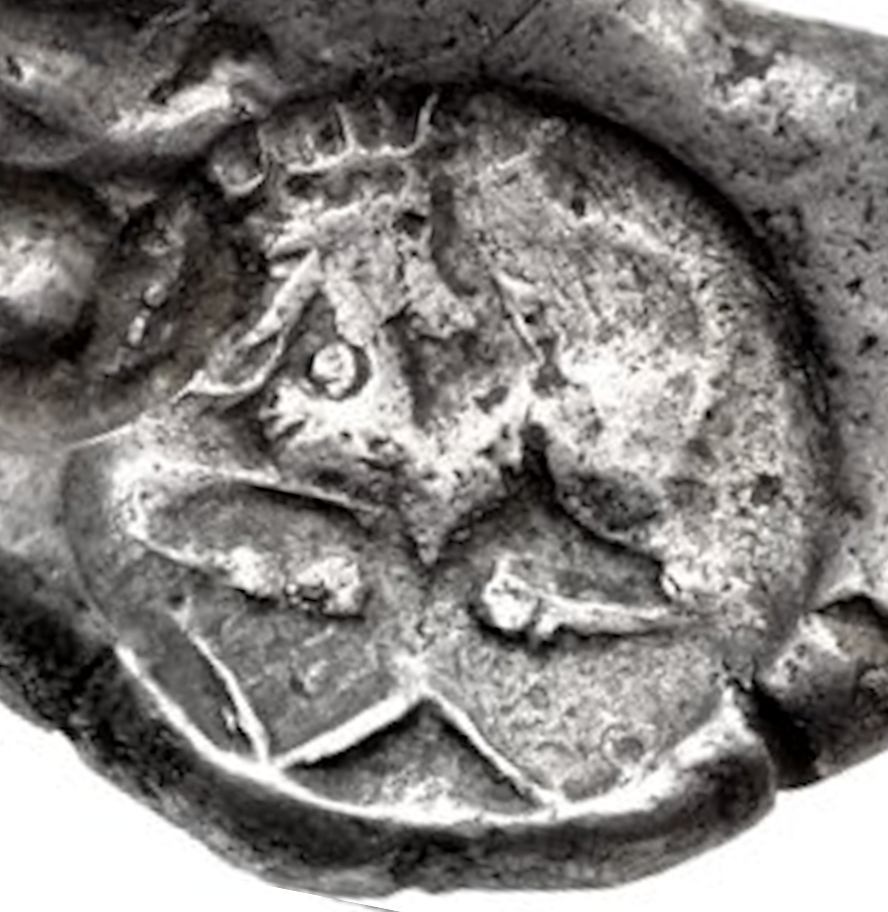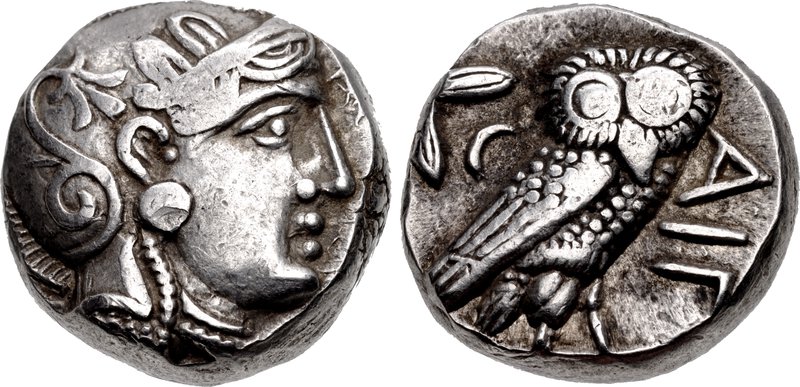|
Punch-marked Coin
Punch-marked coins were a type of karshapana or Ancient Indian coinage, also known as ''Aahat'' (''stamped'') ''coins'', dating to between about the 6th and 2nd centuries BC. It was of irregular shape. These coins are found over most parts of subcontinent and remained in circulation till the early centuries CE. History Janapada Coins The study of the relative chronology of these coins has successfully established that the first punch-marked coins initially only had one or two punches, with the number of punches increasing over time. 19th-century proposals which suggested an origin from as early as 1000 BC, independent of the introduction of coins in Asia Minor, are "no longer given any credence". According to Osmund Bopearachchi, the first punch-marked coins in the Indian Subcontinent may have been minted around the 6th century BC by the Mahajanapadas of the Indo-Gangetic Plain. These coins were produced by impressing single punches individually. According to E. J. Ra ... [...More Info...] [...Related Items...] OR: [Wikipedia] [Google] [Baidu] |
Coin Of The Kuru Kingdom
A coin is a small object, usually round and flat, used primarily as a medium of exchange or legal tender. They are standardized in weight, and produced in large quantities at a mint (facility), mint in order to facilitate trade. They are most often issued by a government. Coins often have images, numerals, or text on them. The faces of coins or medals are sometimes called Obverse and reverse, the ''obverse'' and the ''reverse'', referring to the front and back sides, respectively. The obverse of a coin is commonly called ''heads'', because it often depicts the head of a prominent person, and the reverse is known as ''tails''. The first metal coins – invented in the Ancient Greece, ancient Greek world and disseminated during the Hellenistic period – were precious metal–based, and were invented in order to simplify and regularize the task of measuring and weighing bullion (bulk metal) carried around for the purpose of transactions. They carried their value within the coins t ... [...More Info...] [...Related Items...] OR: [Wikipedia] [Google] [Baidu] |
Coin
A coin is a small object, usually round and flat, used primarily as a medium of exchange or legal tender. They are standardized in weight, and produced in large quantities at a mint in order to facilitate trade. They are most often issued by a government. Coins often have images, numerals, or text on them. The faces of coins or medals are sometimes called the ''obverse'' and the ''reverse'', referring to the front and back sides, respectively. The obverse of a coin is commonly called ''heads'', because it often depicts the head of a prominent person, and the reverse is known as ''tails''. The first metal coins – invented in the ancient Greek world and disseminated during the Hellenistic period – were precious metal–based, and were invented in order to simplify and regularize the task of measuring and weighing bullion (bulk metal) carried around for the purpose of transactions. They carried their value within the coins themselves, but the stampings also induced manip ... [...More Info...] [...Related Items...] OR: [Wikipedia] [Google] [Baidu] |
Hoard Of Mostly Mauryan Coins
A hoard or "wealth deposit" is an archaeological term for a collection of valuable objects or artifacts, sometimes purposely buried in the ground, in which case it is sometimes also known as a cache. This would usually be with the intention of later recovery by the hoarder; hoarders sometimes died or were unable to return for other reasons (forgetfulness or physical displacement from its location) before retrieving the hoard, and these surviving hoards might then be uncovered much later by metal detector hobbyists, members of the public, and archaeologists. Hoards provide a useful method of providing dates for artifacts through association as they can usually be assumed to be contemporary (or at least assembled during a decade or two), and therefore used in creating chronologies. Hoards can also be considered an indicator of the relative degree of unrest in ancient societies. Thus conditions in 5th and 6th century Britain spurred the burial of hoards, of which the most famous a ... [...More Info...] [...Related Items...] OR: [Wikipedia] [Google] [Baidu] |
Panchala
Panchala () was an ancient kingdom of northern India, located in the Ganges-Yamuna Doab of the Upper Gangetic plain which is identified as Kanyakubja or region around Kannauj. During Late Vedic times (c. 1100–500 BCE), it was one of the most powerful states of ancient India, closely allied with the Kuru Kingdom. By the c. 5th century BCE, it had become an oligarchic confederacy, considered one of the ''solasa'' (sixteen) mahajanapadas (major states) of the Indian subcontinent. After being absorbed into the Mauryan Empire (322–185 BCE), Panchala regained its independence until it was annexed by the Gupta Empire in the 4th century CE. Location The Pañcāla state was located to the west of the Gomti river, and the north of the Chambal River. Its western neighbours were the Sūrasenas and the Yakṛllomas, while in the north-west it was separated from the Gaṅgā and the Kurus by dense forests. The northern boundaries of Pañcāla were the forests around the reg ... [...More Info...] [...Related Items...] OR: [Wikipedia] [Google] [Baidu] |
Shaikhan Dehri Hoard
The Shaikhan Dheri hoard is a small coin hoard that was discovered in 2007 at the site of ancient Pushkalavati in modern-day Pakistan. The hoard weighed 14 kilograms, contained "bent bars" as well as round coins "of a new type" as those discovered in the Kabul hoard. The hoard contained a tetradrachm minted in Athens circa 500/490–485/0 BCE, or possibly as early as 520 BCE, together with a number of local types as well as silver cast ingots. The Athens coin is the earliest known example of its type to be found so far to the east."A Truly International Currency", Triton XV, Lot: 1163, ATTICA, Athens CNG Coins This hoard exists in the context of the |
Bhir Mound
The Bhir Mound () is an archaeological site in Taxila in the Punjab province of Pakistan. It contains some of the oldest ruins of Ancient Taxila, dated to sometime around the period 800–525 BC as its earliest layers bear "grooved" Red Burnished Ware, the Bhir Mound, along with several other nearby excavations, form part of the Ruins of Taxila – inscribed as a UNESCO World Heritage Site in 1980. Context The Bhir Mound archaeological remains represent one stage of the historic city of Taxila. The first town in Taxila was situated in the Hathial mound in the southwest corner of the Sirkap site. It lasted from the late second millennium BC until the Achaemenid period, with the Achaemenid period remains located in its Mound B. The Bhir Mound site represents the second city of Taxila, beginning in the pre-Achaemenid period and lasting till the early Hellenistic period. The earliest occupation on the Bhir mound began around 800-525 BC, and what now appears to be the second phas ... [...More Info...] [...Related Items...] OR: [Wikipedia] [Google] [Baidu] |
Mir Zakah
Mir Zakah is a village in the Mirzaka District of Paktia Province in eastern Afghanistan, and on the old caravan route from Ghazni to Gandhara. Mauryan punch-marked coins have been discovered at Begram and Mir Zakah, indicating early trade or administrative presence in the region. Two of the largest ancient coin deposits ever attested to, were discovered in the village, in 1947 and 1992. The hoards contained over half a million punch-marked coins dating from the late 5th century BC, to the 1st century AD, containing early Indian bent-bar and punch-marked coins, Greek, Graeco-Bactrian, Indo-Greek, Indo-Scythian, Indo-Parthian, and Kushana origins coins. The hoards were plundered in later years, and seen being openly sold, in February 1994, in the Peshawar Peshawar is the capital and List of cities in Khyber Pakhtunkhwa by population, largest city of the Administrative units of Pakistan, Pakistani province of Khyber Pakhtunkhwa. It is the sixth most populous city of Pakist ... [...More Info...] [...Related Items...] OR: [Wikipedia] [Google] [Baidu] |
Kabul Hoard
The Kabul hoard, also called the Chaman Hazouri, Chaman Hazouri or Tchamani-i Hazouri hoard, is a coin hoard discovered in the vicinity of Kabul, Afghanistan in 1933. The collection contained numerous Achaemenid coins as well as many Greek coins from the 5th and 4th centuries BCE.: "The most important and informative of these hoards is the Chaman Hazouri hoard from Kabul discovered in 1933, which contained royal Achaemenid sigloi from the western part of the Achaemenid Empire, together with a large number of Greek coins dating from the fifth and early fourth century BC, including a local imitation of an Athenian tetradrachm, all apparently taken from circulation in the region." Approximately one thousand coins were counted in the hoard.106. Kabul: Chaman-i Hazouri , Center for Environmental Managem ... [...More Info...] [...Related Items...] OR: [Wikipedia] [Google] [Baidu] |
Alexander The Great
Alexander III of Macedon (; 20/21 July 356 BC – 10/11 June 323 BC), most commonly known as Alexander the Great, was a king of the Ancient Greece, ancient Greek kingdom of Macedonia (ancient kingdom), Macedon. He succeeded his father Philip II of Macedon, Philip II to the throne in 336 BC at the age of 20 and spent most of his ruling years conducting Wars of Alexander the Great, a lengthy military campaign throughout West Asia, Western Asia, Central Asia, parts of South Asia, and ancient Egypt, Egypt. By the age of 30, he had created one of the List of largest empires, largest empires in history, stretching from History of Greece, Greece to northwestern History of India, India. He was undefeated in battle and is widely considered to be one of history's greatest and most successful military commanders. Until the age of 16, Alexander was tutored by Aristotle. In 335 BC, shortly after his assumption of kingship over Macedon, he Alexander's Balkan campaign, campaigned in the Bal ... [...More Info...] [...Related Items...] OR: [Wikipedia] [Google] [Baidu] |
Taxiles
Taxiles or Taxilas ( lived 4th century BC) was the Greek chroniclers' name for the ruler who reigned over the tract between the Indus and the Jhelum (Hydaspes) Rivers in the Punjab region at the time of Alexander the Great's expedition. His real name was Ambhi (Greek: Omphis), and the Greeks appear to have called him Taxiles or Taxilas, after the name of his capital city of Taxila, near the modern city of Attock, Pakistan.Diodorus Siculus, ''Bibliotheca''xvii. 86/ref> Life Ambhi ascended to throne of Takshasila. He sent an embassy to Alexander along with presents consisting of 200 Talents of silver, 3,000 fat oxen and 10,000 sheep or more ( both are estimated around 600 talents of silver)a force of 700 horsemen and offered for surrender. He appears to have been on hostile terms with his neighbour, Porus, who held the territories east of the Hydaspes. It was probably with a view to strengthening himself against this foe that he sent an embassy to Alexander, while the latter was ... [...More Info...] [...Related Items...] OR: [Wikipedia] [Google] [Baidu] |
Gandāra
Gandāra, or Gadāra in Achaemenid inscriptions (Old Persian cuneiform: :Wikt:𐎥𐎭𐎠𐎼, 𐎥𐎭𐎠𐎼, , also transliterated as since the nasal "n" before consonants was omitted in the Old Persian script, and simplified as or sometimes )Some sounds are omitted in the writing of Old Persian, and are shown with a raised letteOld Persian p.164https://archive.org/stream/OldPersian#page/n23/mode/2up/ Old Persian p.13]. In particular Old Persian nasals such as "n" were omitted in writing before consonantOld Persian p.17https://archive.org/stream/OldPersian#page/n35/mode/2up/ Old Persian p.25] was one of the easternmost provinces of the Achaemenid Empire in South Asia, following the Achaemenid invasion of the Indus Valley. It appears in various Achaemenid inscriptions such as the Behistun Inscription, or the DNa inscription of Darius the Great.Perfrancesco CallieriINDIA ii. Historical Geography Encyclopaedia Iranica, 15 December 2004. The province was also referred to as P ... [...More Info...] [...Related Items...] OR: [Wikipedia] [Google] [Baidu] |
Achaemenid Conquest Of The Indus Valley
Around 535 BCE, the Persian king Cyrus the Great initiated a protracted campaign to absorb parts of India into his nascent Achaemenid Empire. In this initial incursion, the Persian army annexed a large region to the west of the Indus River, consolidating the early eastern borders of their new realm. With a brief pause after Cyrus' death around 530 BCE, the campaign continued under Darius the Great, who began to re-conquer former provinces and further expand the Achaemenid Empire's political boundaries. Around 518 BCE, the Persian army pushed further into India to initiate a second period of conquest by annexing regions up to the Jhelum River in what is today known as Punjab. At peak, the Persians managed to take control of most of modern-day Pakistan and incorporate it into their territory. The first secure epigraphic evidence through the Behistun Inscription gives a date before or around 518 BCE. Persian penetration into the Indian subcontinent occurred in multiple stages, begi ... [...More Info...] [...Related Items...] OR: [Wikipedia] [Google] [Baidu] |







